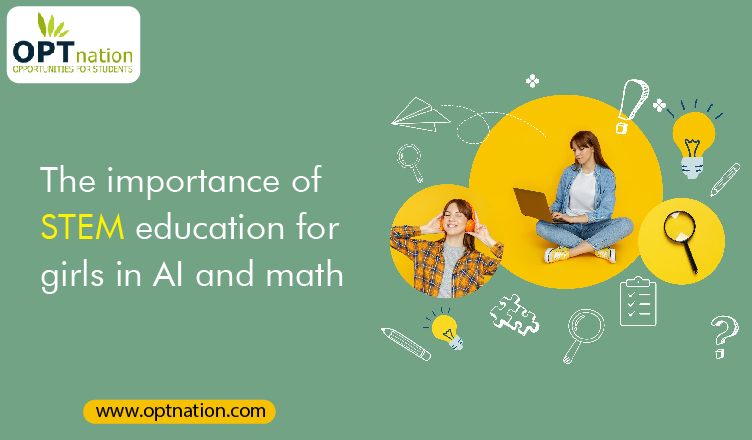STEM education—science, technology, engineering, and mathematics—is more than just a set of academic disciplines. It’s a foundation for innovation, problem-solving, and future careers that will shape the world. However, there remains a glaring gender gap in these fields, particularly in AI and mathematics. Why? Societal norms? Lack of encouragement? The notion that math and tech are “male-dominated” spaces? Whatever the reasons, the reality is that fewer girls pursue STEM studies, and that needs to change.
The Gender Gap in STEM
Look at the numbers, and the story becomes clear. According to UNESCO, women make up only 35% of STEM students worldwide. In AI, the disparity is even starker: just 22% of AI professionals are women. The situation isn’t much better in mathematics. A report by the American Mathematical Society found that while girls perform equally well as boys in math during school years, far fewer women pursue higher education and careers in mathematical fields.
Is it about ability? No. Studies have debunked that myth over and over again. Girls can be just as strong in math and technology as boys. The problem is often a lack of role models, biases in early education, and societal expectations that subtly discourage girls from seeing themselves as future AI engineers, data scientists, or mathematicians.
Why STEM Education for Girls Matters
Encouraging girls in STEM isn’t just about equality—it’s about progress. AI is shaping the future, from healthcare to finance, from climate modeling to autonomous systems. If the field lacks diverse perspectives, AI will reflect the biases of its limited creators. In other words, an AI world built predominantly by men could reinforce gender stereotypes rather than break them.
Mathematics is the backbone of AI. Machine learning? Data science? Cryptography? All rely on advanced mathematical concepts. If girls aren’t entering these fields, they’re being excluded from some of the most high-impact careers of the 21st century. And let’s not forget: STEM jobs pay significantly more than non-STEM jobs, meaning economic opportunities are also at stake.
Breaking Barriers: Encouraging More Girls in STEM
Mathematics in the modern world is not just about solving equations. Even Math Solver AI Homework Helper can solve almost any problem. Moreover, all you need is to upload a photo to the AI helper app. Mathematics now is more about understanding the laws of the digital world, the ability to navigate it and find patterns. The following strategies can help with this:
1. Role Models and Mentorship
Girls need to see women excelling in AI and math. Visibility is power. When young girls see female data scientists, AI engineers, and mathematicians leading the way, they realize these fields are not just for men. Programs like Girls Who Code, Women in AI, and female-led STEM initiatives provide exposure and mentorship.
2. Early STEM Engagement
The earlier girls are introduced to STEM, the better. Studies show that by age 6, many girls start associating math and science with boys. That’s unacceptable. Hands-on STEM experiences—robotics kits, math puzzles, coding games—can ignite curiosity before stereotypes take hold.
3. Challenging Stereotypes
“Girls aren’t good at math.” A ridiculous statement, yet one that lingers in classrooms and homes. Teachers and parents must actively challenge these notions. Praise problem-solving skills. Normalize failure as part of learning. Encourage girls to see logic and computation as creative tools rather than intimidating obstacles.
4. Curriculum That Reflects Diversity
Too often, STEM history is told through a male lens. Where are the stories of Ada Lovelace, the first computer programmer? Katherine Johnson, the NASA mathematician? The curriculum must highlight these contributions so girls feel connected to the legacy of STEM, not separate from it.
5. Inclusive AI and Math Programs
Universities and institutions should offer scholarships, boot camps, and hackathons specifically for young women. Tech companies should fund initiatives that make AI and math more accessible. Government policies can also incentivize STEM participation through grants and outreach programs.
The Future: More Women in AI and Math
The world is moving towards a more AI-driven society. Algorithms shape what we see online, how businesses operate, even how diseases are diagnosed. If we fail to include female perspectives in AI development, the technology of the future will reflect narrow viewpoints and inherent biases.
In math, breakthroughs in areas like quantum computing, cryptography, and finance demand diverse thinkers. The next generation of mathematicians must include women. The numbers need to shift. The landscape must change. We can’t afford to leave half the population behind.
Conclusion
STEM education for girls isn’t just important—it’s essential. The barriers are real, but so are the solutions. More role models. More encouragement. More investment in programs that spark a love for AI and math in young girls.
Because when girls see themselves as scientists, mathematicians, and AI engineers, the future isn’t just brighter—it’s smarter, fairer, and more innovative.

